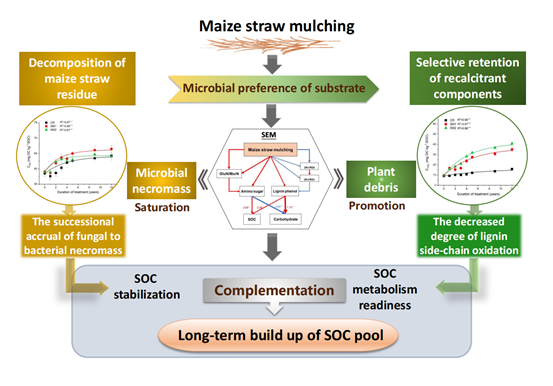The Build-up of Soil Organic Carbon Pool in Conservation Agriculture is Determined by the Complementation between Microbial- and Plant-derived Components
No-tillage combined with straw return has been recognized as a key technology for promoting sustainable agriculture, effectively increasing soil organic matter stock. As a continuum, soil organic matter can coexist with both undecomposed plant-derived components and highly oxidized microbial-derived assimilated carbon. Organic material inputs serve as the controlling pump for soil carbon cycling, forming soil organic carbon (SOC) through substrate-microorganism interactions. However, the potential mechanism of how long-term straw mulching promotes the build-up of SOC pools remains unclear.
LI Yi, a doctoral candidate of the Soil and Environmental Biochemistry Team of the Institute of Applied Ecology, Chinese Academy of Sciences, recently completed a research quantifying the dynamic changes of amino sugars and lignin phenols in soil over 12 years of no-tillage and straw mulching at the National Farmland Ecosystem Observation Research Station in Shenyang, Liaoning Province. The contribution mechanism of microbial-derived and plant-derived components to SOC sequestration and stabilization under conservation tillage was investigated, laying the foundation for enhancing soil organic matter and comprehensive management of Northeast farmland.
The results showed that the content of amino sugars in soil increased exponentially and reached a relatively stable (equilibrium) state after 12-year straw mulching, indicating that the maximum “Microbial carrying capacity” limit has been reached under long-term straw mulching system. With prolonged duration of conservation tillage and increasing rate of maize straw return, the ratio of amino sugars to lignin continued to decrease, accompanied by a decrease in the degree of lignin side-chain oxidation, reflecting that straw mulching promoted the selective retention of fresh plant-derived lignin to a greater extent. When the contribution of amino sugars to SOC reached a stable (equilibrium) state, lignin could prolong the contribution to SOC and play a continuation role. Meanwhile, with the prolongation of straw mulching years and the increase of straw mulching amount, the accumulation of fungal necromass in soil increased faster than bacterial necromass, which also improved the stability of microbial-derived components in SOC pool.
This study highlights the functional complementation between microbial necromass and plant residues in conservation agriculture, which determines the long-term accumulation and stabilization of SOC pool, with microbial-derived components contributing to the stability of SOC and plant-derived components enhancing its metabolic readiness.
This research was founded by the National Natural Science Foundation of China, the Strategic Priority Research Program of the Chinese Academy of Sciences and the Innovation team for research, development and application of conservation tillage in Liaoning Province. It has recently been published online in Soil Biology and Biochemistry entitled “Complementation between microbial necromass and plant debris governs the long-term build-up of the soil organic carbon pool in conservation agriculture”.

Fig.1 Structural equation model (SEM) showed how the straw mulching duration period and maize straw amount influence the build-up process of SOC pool (Image by LI Yi).

Fig.2 Differential characteristics and stability mechanisms of SOC accumulation from microbial- and plant-derived components under long-term straw mulching system(Image by LI Yi).
YUE Qian
Institute of Applied Ecology, Chinese Academy of Sciences
Tel: 86-24-83970317
E-mail: yueqian@iae.ac.cn
Web: http://english.iae.cas.cn



